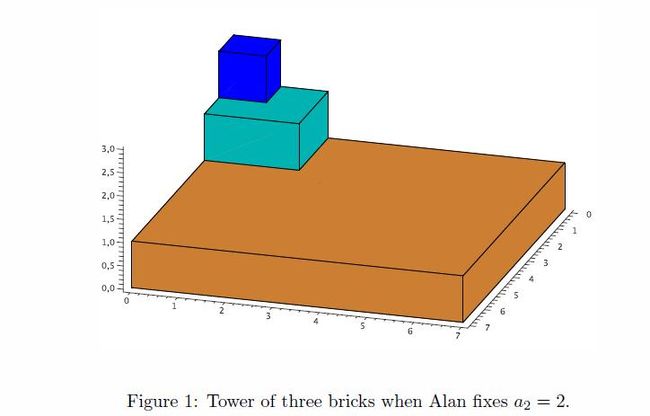HDU 2971(数论,构造矩阵+矩阵乘法优化)
Tower
Time Limit: 10000/5000 MS (Java/Others) Memory Limit: 32768/32768 K (Java/Others)
Total Submission(s): 601 Accepted Submission(s): 154

Recently in math class, the concept of volume was introduced to Alan. Consequently, he wants to compute the volume of his tower now. The lengths of cuboids bases (from top to bottom) are constructed by Alan in the following way:
1. Length a1 of the first square is one.
2. Next, Alan fixes the length a2 of the second square.
3. Next, Alan calculates the length an (n > 2) by 2*a2*(an-1)-(an-2). Do not ask why he chose such
a formula; let us just say that he is a really peculiar young fellow. For example, if Alan fixes a2 = 2, then a3 = 8 -a1 = 7; see Figure 1. If Alan fixes a2 = 1, then an = 1 holds for all n belong to N; see Figure 2.
Now Alan wonders if he can calculate the volume of tower of N consecutive building bricks. Help Alan and write the program that computes this volume. Since it can be quite large, it is enough to compute the answer modulo given natural number m.
3 2 3 100 1 4 1000 3 3 1000000000
54 4 299
先假设a2 = t, 题目给定了递推关系:An = 2 * t * An-1 - An-2 (n > 2),初值A1 = 1, A2 = t;题目要求Sn = An ^ 2 + An-1 ^ 2 + ... + A1 ^ 2。
反复应用递推关系得到:

然后Sn-1利用相同的方式展开,把4tAn-2An-3约去,得到:
![]()
这样就比较容易得出Sn的通项:
![]()
#include <iostream> using namespace std; #define N 4 struct Mat { __int64 martix[N][N]; void clear() { memset(martix,0,sizeof(martix)); } }; __int64 MOD,a2,n; int a[5]; Mat res,q; Mat Martix_Mul(Mat &a,Mat &b) { int i,j,k; Mat c; c.clear(); for (i = 0;i < N;i++) for (j = 0;j < N;j++) { for (k = 0;k < N;k++) if (a.martix[i][k] && b.martix[k][j]) c.martix[i][j] = (c.martix[i][j] + a.martix[i][k] * b.martix[k][j]) % MOD; } return c; } int main() { int t,i,j; int sum; __int64 temp,temp1; scanf("%d",&t); while (t--) { scanf("%I64d%I64d%I64d",&a2,&n,&MOD); for(i=0;i<N;i++) { for (j=0;j<N;j++) { res.martix[i][j]=(i==j); } } q.clear(); temp=(a2*a2)%MOD; q.martix[1][0]=q.martix[2][1]=q.martix[3][2]=1; q.martix[0][0]=(4*temp)%MOD; q.martix[0][1]=(2-8*temp)%MOD; q.martix[0][2]=(4*temp)%MOD; q.martix[0][3]=-1; temp1=(2*a2*a2-1)%MOD; a[0]=0; a[1]=1; a[2]=(1+a2*a2)%MOD; a[3]=(a[2]+(temp1*temp1)%MOD)%MOD; if(n==2) { printf("%d/n",a[2]); continue; } else if(n==3) { printf("%d/n",a[3]); continue; } n-=3; while (n) { if(n&1) res=Martix_Mul(res,q); q=Martix_Mul(q,q); n>>=1; } sum=0; for (i=0;i<4;i++) { sum=(sum+(res.martix[0][i]*a[3-i])%MOD)%MOD; if(sum<0) sum+=MOD; } printf("%d/n",sum%MOD); } return 0; }